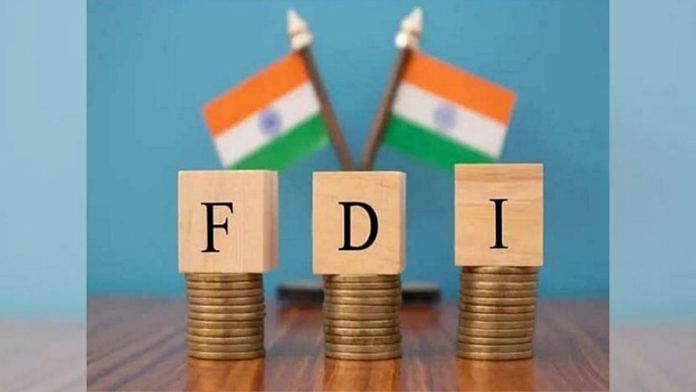The narrative surrounding India’s economic growth often carries declarations of large increases in Foreign Direct Investment or FDI. Yet, the headline FDI figures often mask nuances.
At its core, FDI is the infusion of foreign capital into domestic enterprises and is seen as a signal of investor confidence. However, there are distinctions between gross and net flows, flows by foreign firms in India and Indian firms abroad, as well as new money and reinvestment of earnings. Each of these signifies a different aspect of the FDI story.
One needs to be careful about which metric is used to explain what phenomenon.
FDI inflows
FDI has two routes to enter India: foreign firms bringing in capital (both equity and debt) to make new investments and existing foreign firms choosing to reinvest earnings. These make up the FDI “inflows” into India. It is useful to look at annual numbers, as they give us a more comprehensive picture of a year.
FDI inflows have been falling in the recent few years: the maximum India has received since 2011-12 was $84.8 billion in 2021-22. Within two years, this had fallen to $70.9 billion in 2023-24. The fall in FDI inflows is driven by a decline in new equity investments.
In 2021-22, equity investments by foreigners into India were at $59.6 billion, while debt investments were at $5.8 billion. In 2023-24, new equity investments fell to $45 billion and debt investments to $5.3 billion. Reinvestment of earnings has held steady between the years at roughly over $19 billion.
Foreign money also leaves India. These are the FDI “outflows”. In 2011-12, FDI outflows from India were at $13.6 billion. In 2021-22 the outflows had increased to $28.6 billion. In 2023-24, the total outflows were at $44.4 billion.
The net FDI by foreign firms, therefore, gives us a picture of the difference between foreign money that came into India, and Indian money that went out of it. In 2011-12, net FDI flows by foreign firms stood at $32.9 billion. By 2021-22, these had increased to $56.2 billion, but in 2023-24 these fell to $26.4 billion. Even in nominal terms, this was lower than the same in 2011-12.
Less of “new investment” is coming into India and more of it is leaving India.
Also read: Why India shouldn’t join RCEP. It will stifle economy, undo PLI progress
FDI outflows
Indian firms also make decisions about investing outside of India. In 2011-12, the total inflows by Indian firms from other markets were about $2.4 billion. By 2023-24, these increased to $3.6 billion. The total outflows from Indian firms also increased from $13 billion in 2011-12 to $20.3 billion in 2023-24.
Both direct investments and reinvestment of earnings abroad by Indian firms have increased. On the one hand, this signifies the maturity of Indian firms in expanding to markets outside India. On the other hand, this might signal a lack of investment avenues within India. One has to arrive at a calibrated view of what is really going on.

Net FDI, therefore, is not just the difference between the FDI flows of foreign firms in India, but also of the FDI flows by Indian firms abroad. When we see this in the aggregate, the net FDI flows were $22 billion in 2011-12. They were at the highest ever in 2020-21 at $44 billion, fell to $28 billion in 2022-23, and were at $9.8 billion in 2023-24.
The numbers presented so far are nominal values. The US inflation rate has been very high in the last few years. If one were to adjust these numbers for inflation, net FDI flows in real terms (as of 2011-12) would be $21.37 billion in 2022-23 and $7.1 billion in 2023-24. As described earlier, even if we were only focused on net investments by foreign firms, this has fallen since 2011-12.
Also read: India’s middle class is the forgotten backbone. It needs an advocacy group: Karti Chidambaram
What does FDI show?
India has historically underperformed on FDI relative to other countries—we have never been able to exceed 4 per cent of GDP, so this is not a recent phenomenon. However, to understand and diagnose the current dynamics, we have to first agree on which metric of FDI is the relevant one for a purpose.
Global economic challenges are likely to be a key factor for the recent decline in net flows. But we have to ask if there are also changes in investor perception of the risks of investing in India.
In a similar vein, the increasing global competitiveness of Indian firms is likely to be a reason for their investing abroad. But we must also ask if this signals a weakening of domestic opportunities.
A careful and candid assessment of the data will offer insights into not just the FDI but also the broader health of the Indian economy.
Renuka Sane is managing director at TrustBridge, which works on improving the rule of law for better economic outcomes for India. She tweets @resanering. Views are personal.
(Edited by Prasanna Bachchhav)






